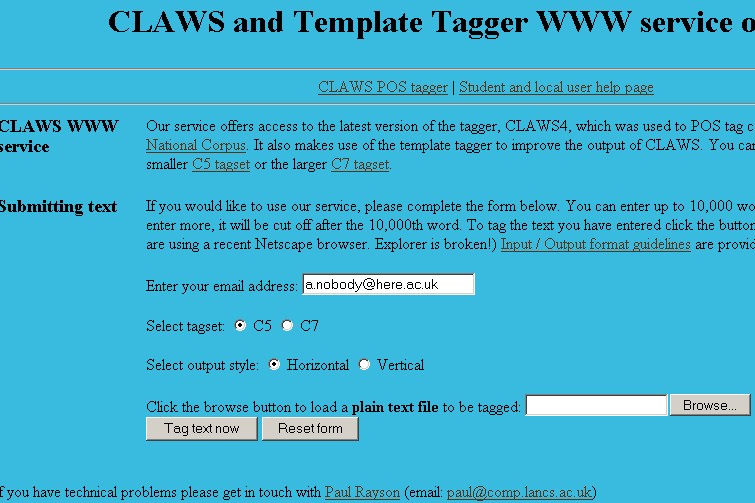 |
 |
| Corpus Linguistics Home |
| Page index |
 |
 WordSmith WordSmith |
 BNCweb BNCweb |
 DIY Corpora DIY Corpora |
 Building DIY Corpora Building DIY Corpora |
 Headers in DIY Corpora Headers in DIY Corpora |
Page One |
Page Two |
Page Three |
Current page |
|||
Using CLAWS over the WebIn order to answer some research questions, a plain corpus may not be enough and you may need to annotate your data with POS tags. This will enable you to refine your searches through your corpus. For example, you may be interested in how the demonstratives this and that are distributed in your data. For this, you will need to distinguish between that used as a subordinating conjunction (e.g. I think that...) and that used as a demonstrative (e.g. That problem was...). The part of speech tags will help you to do this. Previously, we looked at CLAWS, the Part of Speech tagger developed at Lancaster University. You can get limited access to the tagger on the Internet. You can submit only one file at a time and the file cannot exceed 10 thousand words. Before you use CLAWS you need to prepare your file. Let's assume your corpus consists of recent news articles in the major British newspapers. You can get access to news reports pubilshed in the most popular British newspapers through the Newsbank stored in the Library's website. In order to retrieve a file follow the steps below: 1 Go to http://libweb.lancs.ac.uk 2 Click on Databases & e-journals and then on to Newsbank and Start Search 3 Type any phrase that you want your article to contain and choose the newspapers you are interested in. 4. Submit your query. 5. Choose an article for the list of results (preferably a longer one, containing at least a few paragraphs) and save it in your directory on the hard disk as a text file. Click here if you don't remember how to do this. Now you have a file to run through CLAWS. Follow the steps below. 1. Go to http://lingo.lancs.ac.uk and choose the option CLAWS & TT. You will get a screen like the one below:
2. Enter your email address, select your options (preferably C7 horizontal format) and browse the disk for your file. 3. Submit the query and wait while CLAWS is tagging the data (this can take a couple of minutes if the file is long). 4. Click on the link a plain a text file (the upper one) and save the result as a text file (use the ".tag") extension so you will not get confused later. Now you can search your file for the demonstratives this and that. Follow the steps below.
1. Open the Concord tool in WordSmith.
Which demonstrative is used more frequently?
Additional exercises
|
||||||



